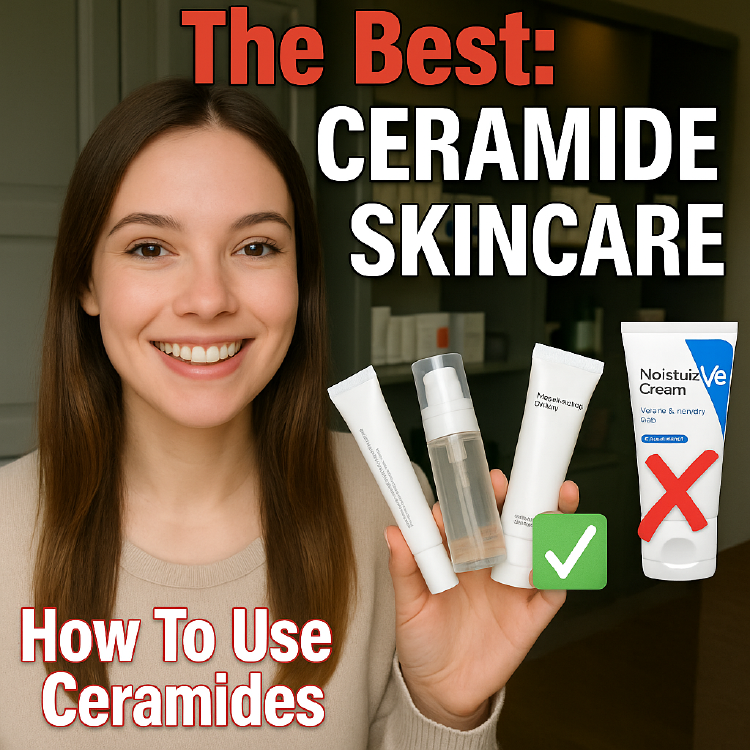Ceramides in Skincare: Are You Being Scammed?
Uncover the truth about ceramide skincare products! Are they effective or just clever marketing? Learn about proper formulations and ratios.

- Seo Yuna
- 5 min read

The Ceramide Deception: Are Your Skincare Products a Waste of Money?
You’ve probably heard the buzz about ceramides and their amazing benefits for your skin. Marketed as the holy grail for a healthy skin barrier, ceramide-infused products are everywhere. But is it all hype? A deep dive into the science reveals a potentially unsettling truth: many ceramide products on the market are likely ineffective due to low concentrations and incorrect formulations.
What are Ceramides and Why Do They Matter?
Ceramides are waxy lipid molecules that are naturally present in the skin and play a crucial role in maintaining a healthy skin barrier. Think of them as the ‘mortar’ between skin cells (‘bricks’), preventing water loss (Transepidermal Water Loss or TEWL) and protecting against external irritants. Along with cholesterol and free fatty acids, ceramides form a liquid crystal structure that’s vital for skin hydration and overall health. They are especially beneficial for:
- Skin suffering from atopic dermatitis
- Skin adjusting to retinoid use
- Skin damaged by harsh treatments or environmental factors.
The Importance of Proper Formulation: Ratios and Concentrations
The effectiveness of ceramides isn’t just about their presence; it’s about how they’re combined with cholesterol and free fatty acids. Research suggests that using ceramides in isolation or in incorrect ratios can actually hinder barrier repair.
Ideal Ratios:
The ideal molar ratio for ceramides, cholesterol, and free fatty acids is generally considered to be between 1:1:1 and 3:1:1. Different skin conditions may benefit from slightly different ratios. For instance:
- Aged skin might benefit more from a cholesterol-dominant ratio.
- Infant skin might benefit more from a free fatty acid-dominant ratio.
- Eczematic skin might benefit more from a ceramide-dominant ratio.
Irritant contact dermatitis (caused by harsh treatments, weather, etc.) can benefit from any of the above ratios.
The Problem with Plant Oils:
While plant oils contain fatty acids, relying on them as a source of free fatty acids in ceramide products isn’t ideal. Most fatty acids in plant oils are bound to triglycerides and require an enzymatic process to be freed. This process is unpredictable and varies between individuals.
Effective Concentrations:
Studies indicate that a combined concentration of 1% to 1.6% of ceramides, cholesterol, and free fatty acids is effective for barrier repair. At an optimal 3:1:1 molar ratio, the ceramide concentration should be between 0.3% and 0.7%.
Interestingly, this concentration has been shown to outperform petrolatum (a common occlusive) in preventing water loss after just 2 hours.
Ceramides vs. Occlusives: What’s the Difference?
Occlusives like petrolatum create a physical barrier on the skin, providing immediate but temporary relief from water loss. A proper ceramide blend, on the other hand, integrates into the skin’s natural lipid structure, offering long-term barrier repair. While occlusives provide an immediate 50% recovery from baseline water loss, a ceramide blend can achieve a 90% recovery after 8 hours. Combining both strategies offers the best of both worlds: immediate relief and long-term repair.
The SK-Influx Issue
Many skincare companies utilize a raw material blend called SK-Influx. While it contains ceramides, cholesterol, and fatty acids, the concentrations and ratios are often far from optimal.
- SK-Influx contains 1.5% ceramides, 0.5% cholesterol, and 3.5% free fatty acids. The recommended usage is 15% with a .2% final ceramide content. However, it is typically used in concentrations of 1-5%, resulting in only 0.015%-0.075% ceramides. That is approximately 10x less than what researchers showed to be effective.
- The molar ratio of cholesterol, ceramides, and free fatty acids in SK-Influx is approximately 1:2:10, far from the recommended 1:1:1 to 3:1:1 range. This is because the fatty acids in SK-Influx are sodium lauroyl lactylate, which at acidic pH’s, breaks down into lactic acid and lauric acid, the latter of which being a free fatty acid.
Popular Products Using SK-Influx (Often at Ineffective Concentrations):
- CeraVe (likely using SK-Influx at 1% concentration or less)
- Drunk Elephant (Lala Retro Whipped Cream, C-Tango Eye Cream - likely using SK-Influx at 1% or less)
- Stratia Liquid Gold (contains SK-Influx at a 10% concentration)
- Paula’s Choice (Omega+ Moisturizer and other ceramide products likely use SK-Influx at 1% concentration or less)
- Chemist Confessions Mr. Reliable (contains 3% SK-Influx)
Note: These products may still be moisturizing due to other ingredients, but the ceramide content is unlikely to provide significant benefits.
The Exception:
One commonly available product that comes closer to the recommended formulation is Skinceuticals’ Triple Lipid Restore Moisturizer, which contains 2% ceramides, 4% cholesterol, and 2% free fatty acids, resulting in a 1:4:3 molar ratio. Still, the total lipid concentration (8% vs ~1% shown to be effective in research) can be considered overkill, and the price point is high.
What Does This Mean For You?
Don’t blindly trust marketing claims. Analyze ingredient lists and understand the science behind skincare ingredients. The discussion highlights the importance of being an informed consumer and not solely relying on marketing tactics.
While ceramides are essential for healthy skin, many products don’t contain adequate concentrations or the correct ratios to deliver significant benefits. It’s crucial to look for products that are properly formulated and backed by scientific research. A truly effective ceramide product should contain a balanced blend of ceramides, cholesterol, and free fatty acids within the optimal concentration range.
Instead of just focusing on Ceramide-containing products, consumers can try and use products such as Atopalm Intensive Moisturizing cream because of its Multi-Lamellar Emulsion (MLE) system, which has been scientifically studied and proven effective.
Be wary of products touting ceramide content without providing details on the concentration and ratios of the other key lipids. Your skin (and your wallet) will thank you!
Unlock Your Healthiest Skin – Backed by Science and Personalization
Cosmi is your personal AI cosmetologist — offering tailored skincare recommendations and expert advice based on your unique skin type, concerns, and goals.
Visit Cosmi